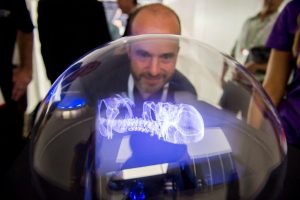Kimberly M. Tarvis

What if?
What if you could see an image in such detail and depth that you swear you could almost touch it? What if this object appeared to be right there in front of you, giving you the opportunity to view it even if it were miles and miles away, what would you think? What if a person appeared before you and started talking to you, but you know they are not there physically in the room? You see your reality, but this is beyond! If this sounds like its from a movie, well, you are almost right. Except this is reality, this is now, this is what is happening in the world today.
Holographic technology allows for users to see what is not there physically, opening up a whole new area of use in education for those who have never experienced, seen, discovered, heard or understood objects and people that were inaccessible to them before. Think of it this way, what if you could speak to a historical figure, take George Washington, the first president of the United States of America? What would you say to him? What would he even look like in person, in real life? How would you describe his mannerisms? Holographic technology allows for people to interact with the example of George Washington through an image that is reflected in the room. George Washington is in the room, except he’s not! His image is being generated through the use of holographic technology, right down to the movement of his fingers and his non-smiling face and starchy attitude. What could students learn about with access to holographic technology? Where could their imaginations go? How could they connect with the past, present and even future selves? The possibilities are endless!
Since the 1960’s, holograms have been a curiosity, where we could “see” into an image that was 3-D in nature (Johnson, 2011). No matter how you looked at the image, you could see more and more of that thing that you were inspecting. Yet, these images were still, non-moving, and non-interactive. Fast forward to present day, we now have augmented reality, which uses a form of holographic technology superimpose an image onto a screen (Kalantari & Rauschnabel, 2018). One of the most prominent augmented reality products for both commercial, educational and personal use is the Microsoft HoloLens (Wyss et al., 2021). As Kalantari & Rauschnabel (2018) illustrate, the headset is worn like a pair of glasses, and the user can see through the lens in reality with an overlay of holographic images that can be programmed to interact with the user when prompted. All the user has to do is reach out and tap the object in the air, or “grab the hologram” to interact. The augmentation of reality with holographic technology is starting to gain traction, and uses in the classroom range from explaining simple math problems to complex biological functions in a non-responsive patient that could have dire life or death consequences based on the user’s decision making (Moro et al., 2021).
What to Expect From This Book
In this PressBook, we explore the historical roots of holographic technology, how holograms work, the use of holographic technology in education, and the future of holographic technology in the field of education, instructional design and beyond. In the words of Dennis Gabor, the father of holography, “the future cannot be predicted, but futures can be invested” (p. 185). How true that statement would actually prove to be in the use of holographic technology for educational purposes throughout the world!
References:
Gabor, D. (1963). Inventing the future. Secker & Warburg.
Johnston, S. F. (2011). Whatever became of holography?. American Scientist, 99(6), 482. https://doi.org/10.1511/2011.93.482
Kalantari, M., & Rauschnabel, P. (2018). Exploring the early adopters of augmented reality smart glasses: the case of Microsoft HoloLens. In T. Jung, & M. T. Dieck (Eds.), Augmented Reality and Virtual Reality. Progress in IS. (pp. 229-245) Springer. https://doi.org/10.1007/978-3-319-64027-3_16
Moro, C., Phelps, C., Redmond, P., & Stromberga, Z. (2020). HoloLens and mobile augmented reality in medical and health science education: A randomized controlled trial. British Journal of Educational Technology, 52(2), 680-694. https://doi.org/10.1111/bjet.13049
Wyss, C., Buhrer, W., Furrer, F., Degonda, A., & Hiss, J. A. (2021). Innovative teacher education education with the augmented reality device Microsoft HoloLens – Results of an exploratory study and pedagogical considerations. Multimodal Technologies and Interaction, 5(8), 1-17. https://doi.org/10.3390/mti5080045
